Samsung Galaxy Tab 10.1 Review: The Sleekest Honeycomb Tablet
by Anand Lal Shimpi on June 13, 2011 5:07 AM EST- Posted in
- Tablets
- Samsung
- Tegra 2
- Galaxy tab 10.1
- Android 3.1
- Mobile
- NVIDIA
A Beautiful Display
Other than form factor, the 10.1's display is the only other major advantage Samsung holds over ASUS. While the Eee Pad's display is quantifiably similar to Apple's iPad 2, it does fall victim to an incredible amount of glare. There's a sizable gap between the LCD panel and the outermost glass, which results in more glare than most other tablets we've reviewed this generation. The 10.1 however doesn't suffer this fate and as a result is more directly comparable to the iPad 2.
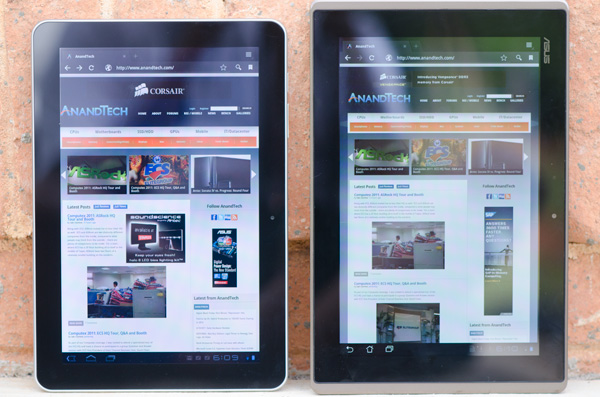
Samsung Galaxy Tab 10.1 (left) vs. ASUS Eee Pad Transformer (right)

Samsung Galaxy Tab 10.1 (left) vs. Apple iPad 2 (right)
While both ASUS and Apple use an IPS panel in their tablets, Samsung uses its own technology called Super PLS (plane line switching). Brian Klug, our resident smartphone and display guru did some digging and it turns out that Super PLS is Samsung's own take on IPS that maintains viewing angle while boosting throughput (brightness). The Samsung supplied photo below shows a comparison of the tradeoff you make with S-IPS and I-IPS, as well as both of those compared to Super PLS:
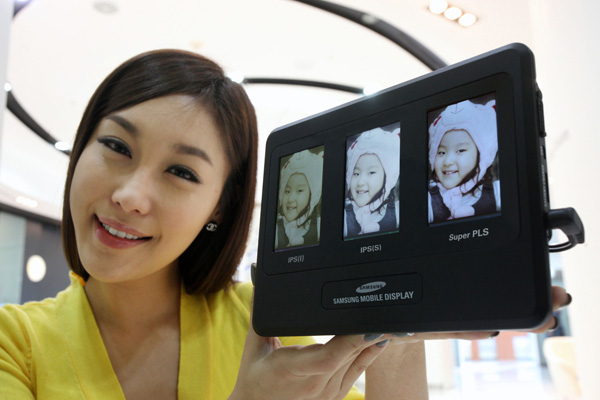
Traditionally you'd have to trade off viewing angle for brightness or vice versa even within the IPS family. Super PLS lets you have your cake and eat it too, giving you the same side viewing angles as S-IPS but with the light throughput of I-IPS.
Perhaps due to the use of Super PLS, Samsung actually managed to outfit the Galaxy Tab 10.1 with a brighter panel than what we saw with the iPad 2. Black levels aren't quite as good but peak brightness is measurably better at nearly 500 nits. While the display isn't what I'd consider bright enough to use in direct sunlight, it is more versatile than the iPad 2's as a result of its brightness.

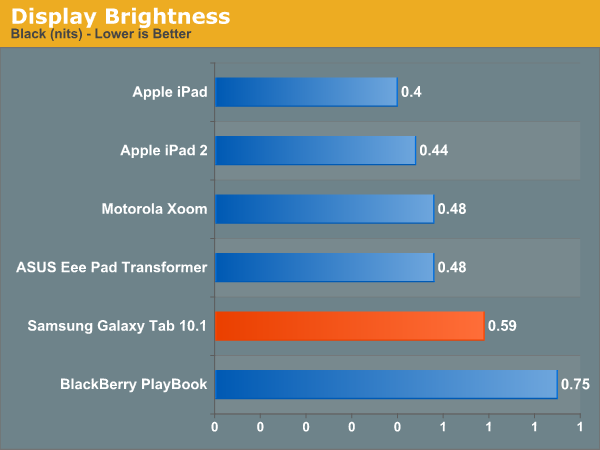
The higher black levels balance out the brighter panel and deliver a contrast ratio comparable to that of the iPad 2:
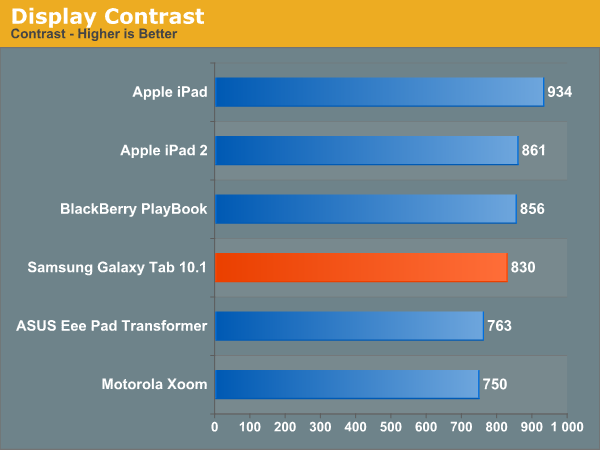
I should mention that the quality of the panel on the retail 10.1 sample is significantly better than what I saw with Samsung's Galaxy Tab 10.1 Limited Edition at Google IO. The sample from IO had noticeably worse black levels, lower peak brightness and as a result lower overall contrast. On top of all of that, the LE suffered light bleed from one of its corners - a problem I haven't seen on the retail 10.1. With only two Galaxy Tabs to compare this is either an indication of wildly varying quality control, or more likely that Samsung simply repackaged its early samples as LEs and saved the mass production hardware for paying customers a month after Google IO.
As you can see in the shot above the Samsung panel has a considerably cooler white point than the Eee Pad Transformer. A quick measure with our colorimeter shows a white point of 8762 (vs 7805K for the Eee Pad). It does make Samsung's default wallpaper look very pretty. If you're wondering, the iPad 2's panel is calibrated to a 6801K white point - at least with our 16GB CDMA sample here.


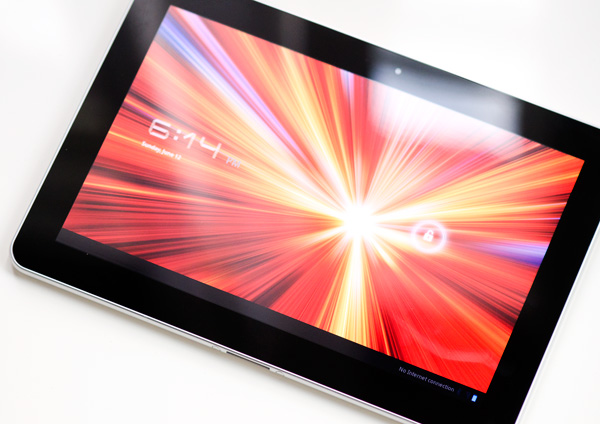
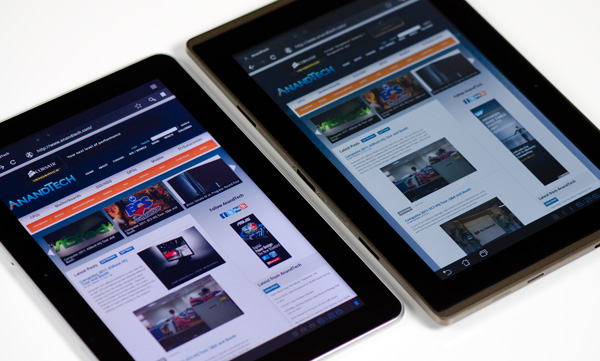








108 Comments
View All Comments
mikehunt80 - Monday, June 13, 2011 - link
Although it's true that the integer performance of Kal-El will be the same clock for clock as Tegra 2. The floating performance with quadruple thanks to the addition of Neon. This makes a big difference when working with complex surfaces, as well as decoding videos that aren't part of the hardware codec.Hrel - Monday, June 13, 2011 - link
I'm really sick of EVERYTHING being compared to the apple version of a similar product. Apple, IS NOT the golden standard. WAY WAY WAY back when the iphone first came out, ok sure. But ever since Android 2.0 was released Apple has been behind on every front.Start comparing the HTC's products or Motorola, like the Droid X. Asus E anything is a step above at least. Or better yet hold Apple to the standards of Archos. Superior build quality, superior functionality, more options and choices as well as being priced less than half as much. Yeah... can't even compete can you Apple. Fucking stupid people...
michael2k - Monday, June 13, 2011 - link
When the iPad can sell 3m in a month and #2 Acer sells 300k, Apple is still the golden standard.Conner_36 - Monday, June 13, 2011 - link
While Apple is selling the most tablets they are the golden standard, just like Google is the golden standard for search (find your own example of company with the significant market share is considered the 'golden' standard).vision33r - Monday, June 13, 2011 - link
When Apple is the one innovating, being 1st and selling millions. That's how gold standard is created.Show me which product Google released 1st other than search that was innovative and successful?
Android OS was conceived to battle iOS so Google can plant more ads without Apple's lock down.
ph00ny - Monday, June 13, 2011 - link
show me a single piece of hardware that apple has innovated that wasn't supplied by samsung, lg, etcBelard - Tuesday, June 14, 2011 - link
UH... what does that have to do with anything? First LG is really more of a brand than a manufacture. Samsung makes most of the LCD panels sold in the world... sound under dozens of names.Hate them or not... Apple did bring out the GUI computer, Smart phone and tablets to the consumer mass.
Jamestownsend - Tuesday, June 14, 2011 - link
Apple isn't a hardware company. Im more likely to call them a software/UI development company. Open any of their devices and you'll see stamps from other companies. they are what i call cherry pickers. they pick the best from everyone, combine it into a pretty case that they made themselves and sell it as an experience.fteoath64 - Wednesday, June 15, 2011 - link
Apple's magic is in their OS software. Their hardware components has been mediocre at best but their integration of the components into the design is their skill. Wrap this in easy-to-use UI/OS, they have a compelling product, hence, they can set the "Gold Standard" because they can cater for 80% of the people out there even with a higher price point.robco - Monday, June 13, 2011 - link
Apple was making the iPhone when there was no Android. They forced everyone else to step up their game. They've been pretty good about releasing new versions that adds new features. They didn't have everything out of the starting gate, but what they put in worked very well.This is where Apple and Google diverge into two opposite directions. Google has made web apps in the past. You can quickly add new features and tweak things. Their products are almost in a state of perpetual beta. GMail was labelled a beta for years. They have no problem adapting new technologies, even if they aren't polished. Apple OTOH tends to pick and choose what it will implement more carefully and won't put a feature into a product until it meets their standards. If you want to be bleeding edge and buzzword-compliant, then Apple products are not for you.
For Apple, it's not just about what the product does, it's about what it does well. I've seen some really nice Android devices, but some of the third-party UIs seem a bit clunky and some of the features are still half-baked. They're differing philosophies. Some people want something that just works, others don't mind getting new features early even if they aren't quite neat and tidy. Neither are wrong, just different.